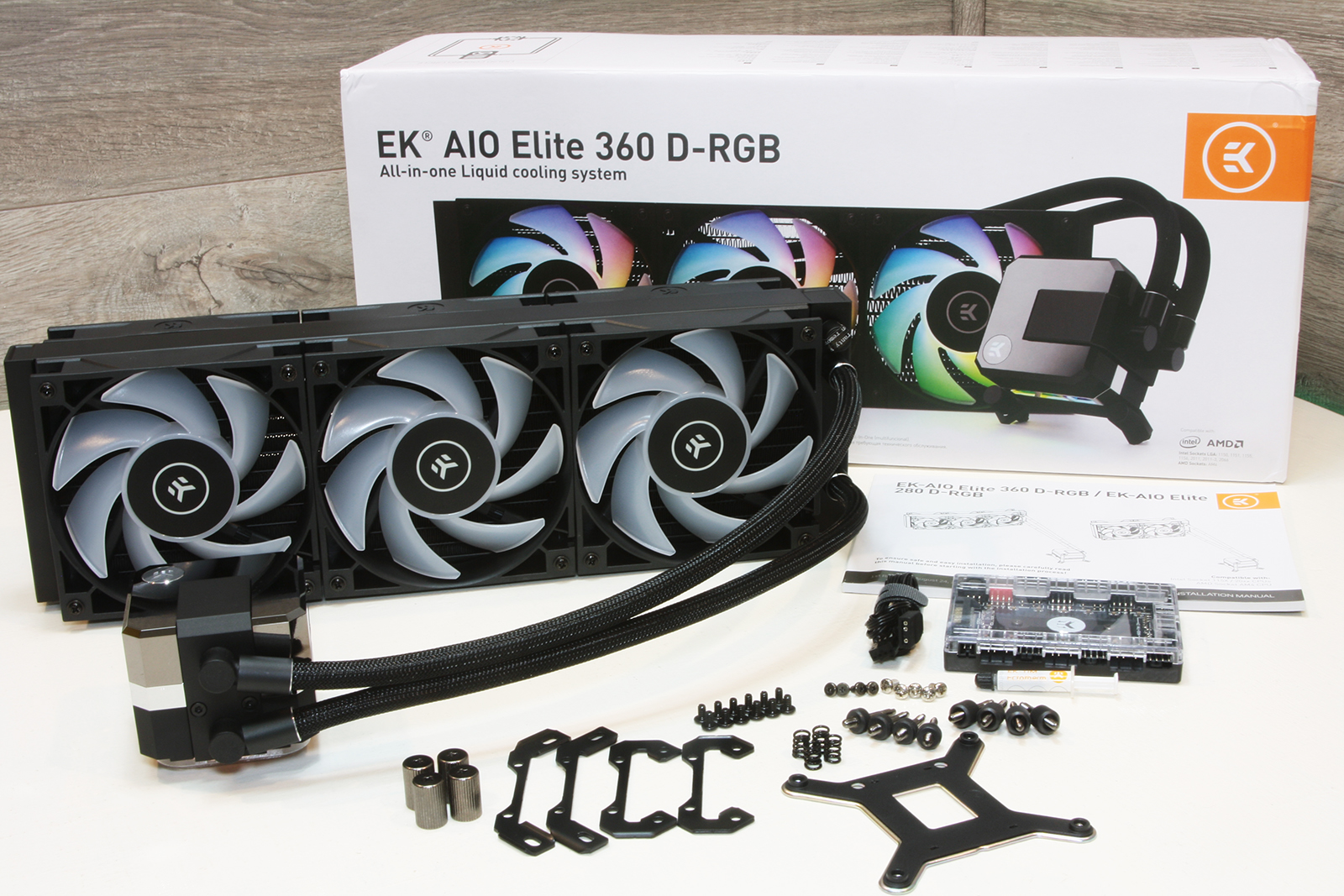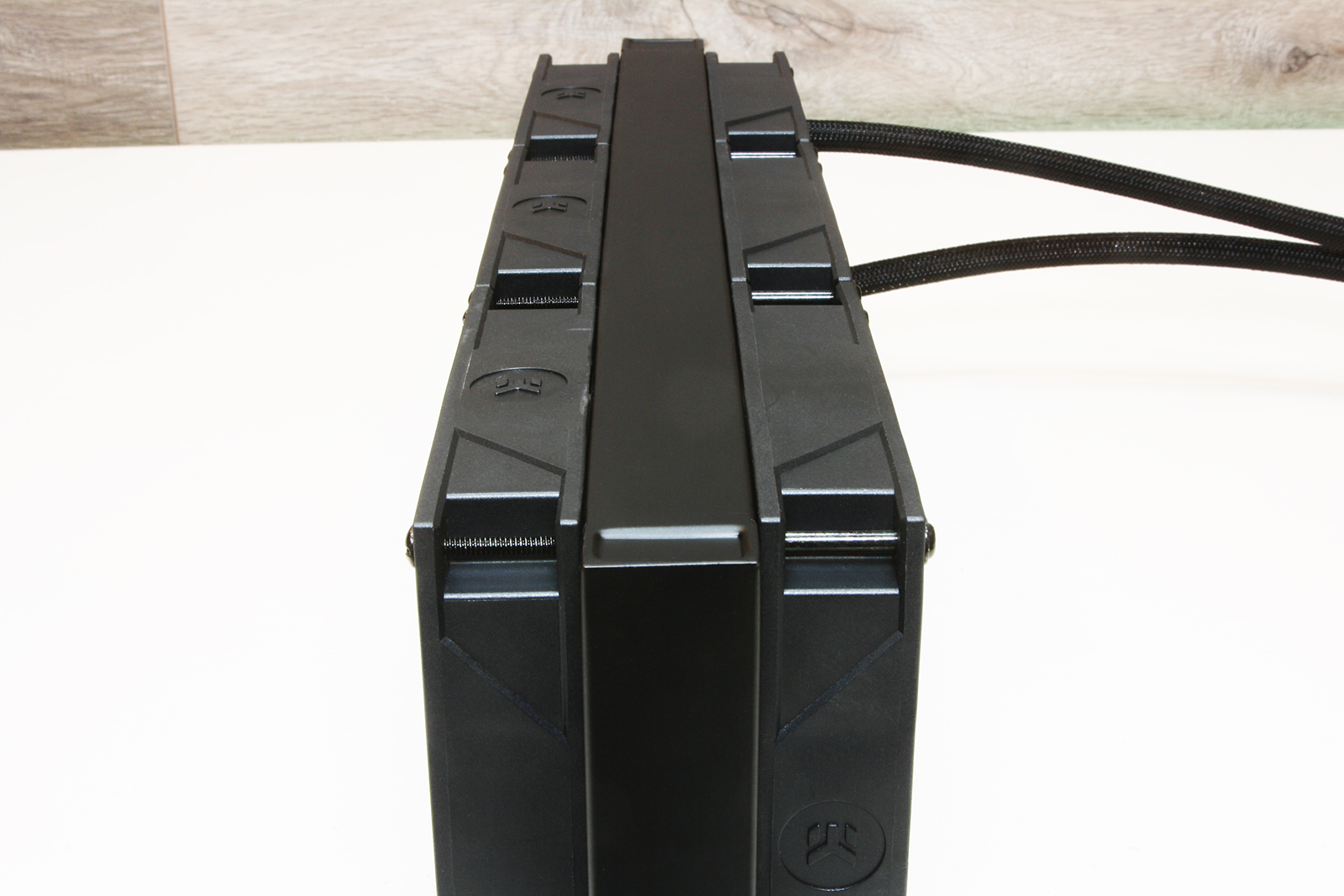Tom's Hardware Verdict
The EK AIO Elite 360 D-RGB offers some of the best cooling performance in a closed-loop cooler, while making use of push+pull radiator fan configuration. It does so at the expense of higher decibel levels, so make sure to read up on how to make use of your motherboards’ BIOS settings for fan curves.
Pros
- +
Sophisticated pump design
- +
Six fans operate in push+pull
- +
Includes aRGB/PWM fan hub
Cons
- -
Noisy when fans operate at full speed
- -
Mounting has to account for added thickness
Why you can trust Tom's Hardware
EKWB, the Slovenian company which specializes in custom watercooling components and kits, has expanded into the closed-loop AIO market, with the six-fan, push+pull EK AIO Elite 360 D-RGB being the latest addition to its AIO line. And while it requires a bit more planning for logistics and case mounting, the cooler’s style and performance notably follow EKWB’s primary DNA.
Specifications
| Thickness | 1.13" / 28.7mm (3.25" / 82.6mm w/fans) |
| Width | 4.75" / 120mm |
| Depth | 15.6" / 394mm |
| Pump Height | 2.5" / 63.5mm |
| Speed Controller | BIOS |
| Cooling Fans | (6) 120 x 25mm |
| Connectors | (7) 4-Pin PWM |
| Row 7 - Cell 0 | (7) 3-Pin aRGB |
| Row 8 - Cell 0 | (1) SATA |
| Weight | 83.0 oz / 2355g |
| Intel Sockets | 115x, 1200, 2011x, 2066c |
| AMD Sockets | AM4 |
| Warranty | 5 years |
| Web Price | $200 |
Features

Following up on EKWB’s original EK AIO lineup, the AIO Elite 360 D-RGB ships with six cooling fans for push+pull operation. Most AIOs make use of a push configuration, meaning the fans force air through the radiator to dissipate out the back. The second set of fans included with the AIO Elite 360 ‘pulls’ the warmed air through the radiator, assisting in the exhaust dissipation much as you’ve probably seen on several big air coolers over the years.
Mounting hardware includes support for most Intel sockets and the addition of AMD’s AM4. The inclusion of an aRGB + PWM fan hub provides centralized lighting and fan RPM control and utilizes a set of PWM and aRGB accessory cabling.
A small syringe of EK-TIM Ecotherm compound tags along to round out the usual installation components.
EKWB covers the AIO Elite 360 D-RGB with a five-year warranty.

The pump of the EKWB AIO Elite 360 D-RGB looks similar to previous versions of EK AIO models, although it brings a much more sophisticated approach by combining angled, mirrored finishes and dark, opaque acrylics. The reflective EK logo provides the only aRGB lighting accent on the pump housing, taking a ‘less-is-more’ approach on lighting accents. A pair of 90-degree swivel fittings allows rotation and movement during pump installation and radiator mounting.

The base plate of the EK AIO Elite 360 is a solid sheet of satin milled copper, which ships with a patch of pre-applied thermal compound already in place. The additional syringe of EK-TIM Ecotherm compound is a nice addition for system builders who need to re-mount the EK AIO Elite after the first original installation or for any hardware upgrades in the coming years during (or after) the 5-year warranty period. EKWB claims an updated and more efficient pump unit is used for the new Elite 360.
Get Tom's Hardware's best news and in-depth reviews, straight to your inbox.
Cabling to support the operation of the pump unit includes an aRGB lighting header for the EK logo backlighting and a 4-pin PWM for pump impeller control.

The base of the EK AIO Elite 360 is milled extremely flat; we are not able to see light peeking between our steel rule and the copper contact plate. A flat surface combined with an alternating ‘X-pattern’ seating of the mounting hardware should provide for a uniform thermal compound mounting patch when we remove the pump from the CPU’s integrated heat spreader (IHS).

Removing the cooler after installation can provide an indication of the success (or failure) of thermal compound spread between the cooler and the top of the CPU and integrated heat spreader (IHS). The EK AIO Elite 360 seated very well atop our i9-10850k.

The EKWB AIO Elite 360 D-RGB arrives with six 120mm Vardar S fans, which are both aRGB and 4-pin PWM managed.

Using three fans to push air into the radiator, while also making use of the three additional fans to extract and exhaust the warm air makes for a push+pull setup, which allows for optimal thermal performance. Of course, the cooler can operate with only three fans like a typical AIO, but then we ask, why would you spend extra for three more fans?

The AIO Elite 360 utilizes a relatively standard aluminum radiator, which has threaded machine screw mounts on both sides for the 120mm Vardar S fans to anchor to.

PWM and aRGB lighting control of the EK AIO Elite 360 D-RGB are managed via the provided fan hub to simultaneously control lighting and fan speed for the connected components, which can include the pump. The hub makes use of a PWM and aRGB header for motherboard and lighting control, or via other modules set up as part of your PC’s lighting and fan control ecosystem. When powered, the EK center logo shines with the same aRGB lighting accents seen on the pump housing.

Installation of the EK AIO Elite 360 is very similar to most other 360mm liquid coolers, with the exception of the extra fan depth required from the push+pull setup. This means that additional clearance is necessary inside cases, so plan to account for that extra inch or 25mm of fan thickness.

Garrett Carver is a contributor for Tom’s Hardware, primarily covering thermal compound comparisons and CPU cooling reviews; both air and liquid, including multiple variations of each.
-
nofanneeded A small hint to EK, which is better ? double the fans or doubling the thickness of the radiator ?Reply
The answer is : Double the Radiator is better . that more thickness is wasted. -
PlanesFly Replynofanneeded said:A small hint to EK, which is better ? double the fans or doubling the thickness of the radiator ?
The answer is : Double the Radiator is better . that more thickness is wasted.
What you neglected to reason out is that 50-60mm radiators need push/pull to work best. Thick radiators also require higher airflow to get the benefit as they are 2 pass and without elevated airflow the 2nd pass nets you little. -
nofanneeded ReplyPlanesFly said:What you neglected to reason out is that 50-60mm radiators need push/pull to work best. Thick radiators also require higher airflow to get the benefit as they are 2 pass and without elevated airflow the 2nd pass nets you little.
True but thats for optimal result . it is still better result with double thick Radiator VS push pull fans and half the radiator. -
Smackaroy Wonder why it performance is a bit better than the other aios, It has 3 extra fans for god sake! this just proves that all aios perform the same it just depends what fans you put on itReply -
TallentedOne I'm curious why you have been using the ML360P Silver Edition in recent comparisons instead of the ML360R? Your own review of the Silver Edition (https://www.tomshardware.com/reviews/cooler-master-masterliquid-ml360p-silver-edition,6341.html) showed it performed worse from a cooling perspective compared to the ML360R.Reply -
Phaaze88 Well, that's a waste.Reply
Surely the manufacturers/engineers know what's holding back performance on hybrid coolers isn't moar fans and moar radiator, but what's on the other end?
¯\(ツ)/¯ -
Darkbreeze Reply
Not higher "airflow" but higher static pressure. You can put fans with 200CFM on there, but if they have .098mm H20 static pressure, they aren't going to do much. In fact, they'll probably do a lot of stalling and suffer from major inversion leakage. A fan with 70CFM and a 2.5mm H20 static pressure however, will likely handle the thicker radiator, or heatsink, just fine.PlanesFly said:What you neglected to reason out is that 50-60mm radiators need push/pull to work best. Thick radiators also require higher airflow to get the benefit as they are 2 pass and without elevated airflow the 2nd pass nets you little.
With 3.16mm H20 static pressure, those 120mm Vardar 120ER RGB fans can likely push their 77CFM through a thicker radiator just fine. Or this radiator for that matter. I'd like to see the same tests done again with ONLY the front three fans installed, to compare the difference. I imagine there isn't a terrific difference, maybe 1-5°C, which makes the cost of the additional three fans that are tacked onto the price of this unit somewhat hard to swallow. Barring some astounding different in performance between a three fan setup compared to six, I'd prefer to see them take the cost of three fans off and sell the unit as is or as mentioned, maybe with a thicker radiator. Those fans have plenty of static pressure and CFM to handle it I think.
It would also be a heck of a lot quieter with only three fans running full out, rather than six. -
Asryan I have the previous version of this aio but might have to rma it.Reply
I am not sure i can fit a push pull but does the new pump makes a difference without being extra noisy at this pump rpm?